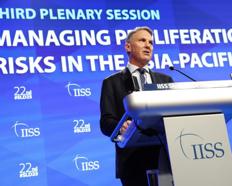U.S. Defense Department Outlines Strategic Vision at Shangri-La Dialogue
During a significant security summit in Singapore today, Defense Secretary Pete Hegseth conveyed the U.S. Department of Defense's (DoD) strategic vision for the Indo-Pacific region, emphasizing the importance of collaboration with Asian allies in the face of escalating tensions with China.
At the esteemed International Institute for Strategic Studies Shangri-La Dialogue, Hegseth began his address by reinforcing the DoD's commitment to achieving "peace through strength," which revolves around restoring the warrior ethos, rebuilding military capabilities, and reestablishing deterrence in the region.
- Increased Focus on the Indo-Pacific: Hegseth highlighted the U.S. intent to prioritize the Indo-Pacific, particularly as allies in the region are beginning to invest more resources into their own defense.
- Shared Burden of Defense: He remarked, "As our allies share the burden, we can increase our focus on the Indo-Pacific: our priority theater," reinforcing the interconnected futures of the U.S. and its allies.
- Mutual Prosperity: The secretary asserted, "The security and prosperity of Americans are linked to the security and prosperity of our allied nations," indicating a belief that regional stability will benefit all involved.
Hegseth articulated a vision for the Indo-Pacific that rests on common-sense approaches and national interests where collaboration occurs under mutual respect for sovereignty and commerce instead of military conflict. He mentioned that as President Trump drives European allies to invest in their defense, the U.S. could redirect more resources into the Indo-Pacific.
Notably, Hegseth clarified that the U.S. does not aspire to impose its ideologies on other countries and seeks cooperative partnerships founded on aligned interests aimed at fostering peace and economic prosperity. “We are here to work with you,” he stated emphatically, positioning the U.S. as a supportive ally rather than a hegemonic power.
Addressing the Dragon: The Threat of China
As part of his discourse, Hegseth identified the rising threat posed by China, clearly stating that the U.S. is not seeking conflict but is resolute in its commitment to not be pushed out of the Indo-Pacific region. He remarked, "But we will not let our allies and partners be subordinated and intimidated." His comments came in light of concerns surrounding China’s military preparations which could potentially change the balance of power.
- Potential Military Aggression: He warned that any military move by China against Taiwan would have catastrophic consequences not just for the region but globally, insisting the threat is both real and possibly imminent.
- Preparation for Conflict: While reiterating the U.S. preference for peace, Hegseth underscored the need for readiness. "If deterrence fails, and if called upon by the commander in chief, we are prepared to do what the Department of Defense does best: to fight and win, decisively," he declared.
Strategies for Strength
Hegseth outlined the U.S. strategy to restore deterrence through three key initiatives:
- Enhancing the Department of Defense's forward posture in the region.
- Helping allies and partners bolster their defense capabilities.
- Reconstructing both U.S. and allied countries' defense industrial bases.
He stressed the significant progress made thus far, while portraying a sense of urgency: "But we have to do this quickly, and we have no time to waste." This emphasis indicates a clear understanding of the rapidly evolving security dynamics in the Indo-Pacific.
In conclusion, Hegseth called upon both the U.S. and its regional allies to prepare for potential challenges ahead, reinforcing that the time for action is immediate: "Our time is now... the threats we all face will not wait. Nor can we." This rallying cry encapsulates the Department of Defense's proactive stance in navigating a complex geopolitical landscape.
Bias Analysis
Key Questions About This Article




